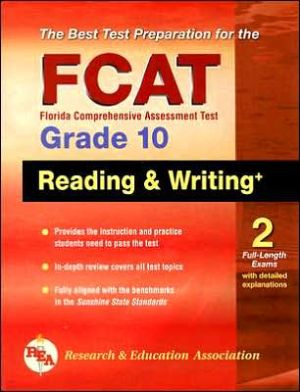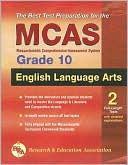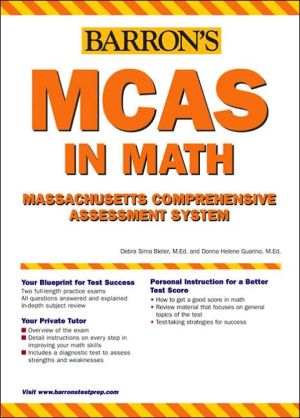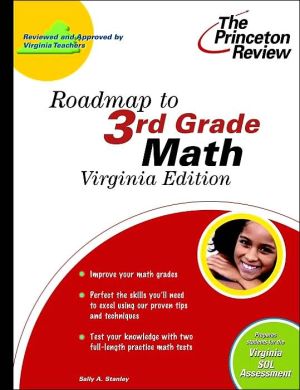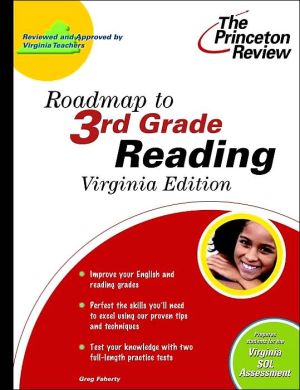FCAT Reading and Writing+, Grade 10 -- (REA), The Best Test Preparation
REA Real review, Real practice, Real results.\ \ REA's Florida Grade 10 FCAT Reading & Writing Study Guide!\ Fully aligned with the benchmarks in the Sunshine State Standards\ \ Are you prepared to excel on this state high-stakes assessment exam? \ * Passing the exam is required to receive a high school diploma\ * Find out what you know and what you should know\ * Use REA's advice and tips to ready yourself for proper study and practice\ \ Sharpen your knowledge...
Search in google:
REA … Real review, Real practice, Real results. REA's Florida Grade 10 FCAT Reading & Writing Study Guide!Fully aligned with the benchmarks in the Sunshine State Standards Are you prepared to excel on this state high-stakes assessment exam? * Passing the exam is required to receive a high school diploma* Find out what you know and what you should know* Use REA's advice and tips to ready yourself for proper study and practice Sharpen your knowledge and skills* The book's full subject review refreshes knowledge and covers all topics on the official exam, including vocabulary, literary analysis, drafting and revising, and skill-building exercises to reinforce key English language lessons* Smart and friendly lessons reinforce necessary skills* Key tutorials enhance specific abilities needed on the test* Targeted drills increase comprehension and help organize study* Color icons and graphics highlight important concepts and tasks Practice for real* Create the closest experience to test-day conditions with two full-length practice tests* Chart your progress with detailed explanations of each answer* Boost confidence with test-taking strategies and focused drills Ideal for Classroom, Family, or Solo Test Preparation! REA has helped generations of students study smart and excel on the important tests. REA’s study guides for state-required exams are teacher-recommended and written by experts who have mastered the test.
Succeeding on the FCAT Reading and Writing1, Grade 10\ About This Book This book will provide you with an accurate and complete representation of the Reading and Writing1 sections of the Florida Comprehensive Assessment Test (FCAT). Inside you will find reviews that are designed to provide you with the information and strategies needed to do well on the FCAT. Four practice tests (two reading and two writing) are provided, all of which are based on the official FCAT. The practice tests contain every type of question that you can expect to encounter on the FCAT Reading and Writing1 tests. Following each test, you will find an answer key with detailed explana-tions designed to help you master the test material.\ About the Test Who Takes the Test and What Is It Used For?\ The FCAT is given to public school students throughout Florida to measure achievement in the skills and competencies outlined in the Sunshine State Standards. The FCAT consists of four sections: Reading, Writing, Mathematics, and Science. FCAT Reading is given to students in Grades 3 through 10. FCAT Writing1 is administered to students in Grades 4, 8, and 10. Students must pass the read-ing portion of the tenth-grade FCAT in order to receive a high school diploma.\ When and Where Is the Test Given?\ FCAT Writing1 is administered to students in Florida public schools in February. FCAT Reading is administered to students in March. Students who need to retake the reading portion of the Grade 10 FCAT may do so in June, October, and March during their eleventh- and twelfth-grade years.\ Is There a Registration Fee?\ No. Because all Florida public high school students are required to take the FCAT and pass the test in order to receive a high school diploma, no fee is required.\ Test Accommodations and Special Situations Every effort is made to provide a level playing field for students with disabilities taking the FCAT and seeking a standard high school diploma. Special accommodations are permitted for students who:\ —have been assigned to a special program, according to State Board Rule 6A-6.0331, FAC, and\ —have a current Individual Educational Plan (IEP).\ Federal law requires the inclusion of exceptional education students in all regular assessment programs. The school, district, and state FCAT score averages represent all students taking the test, including students with disabilities.\ In addition, students with limited English proficiency (LEP) are expected to take the FCAT. LEP students may be exempt from participating in the statewide assessment program:\ —if the student has been receiving services in an approved district LEP plan for one year or less, and\ —if the student's LEP committee determines that the FCAT is not appropriate.\ LEP students may take the FCAT using accommodations appropriate for the particular need of the student. It is the responsibility of local school educators to work with students and parents to identify the allowable testing accommodations.\ Additional Information and Support Additional resources to help you prepare to take the FCAT include:\ —the official FCAT website at http://firn.edu/doe/sas/fcat.htm\ —the Florida Department of Education website at http://www.fldoe.org/\ How to Use This Book What Do I Study First?\ Read over the review sections and the suggestions for test-taking. Studying the review sections thor-oughly will reinforce the basic skills you need to do well on the test. Be sure to take the practice tests to become familiar with the format and procedures involved with taking the actual FCAT.\ When Should I Start Studying?\ It is never too early to start studying for the FCAT. The earlier you begin, the more time you will have to sharpen your skills. Do not procrastinate! Cramming is not an effective way to study, since it does not allow you the time needed to learn the test material. The sooner you learn the format of the exam, the more time you will have to familiarize yourself with the exam content.\ Format of the FCAT Reading and Writing1\ Overview of the Reading and Writing1 Portions of the FCAT The Reading and Writing1 portions of the FCAT are designed to test students' ability to read and write, knowledge of basic literary concepts, and familiarity with basic writing strategies. Each FCAT Reading exam has 45 to 50 multiple-choice questions and 5 to 7 short- or extended-response questions.\ The types of passages included on FCAT Reading are as follows:\ Forms of Information Text Forms of Literary Text Subject-area text (e.g., science, history) Short stories Magazine and newspaper articles Literary essays (e.g., critiques, personal narratives)\ Diaries Excerpts Editorials Poems Informational essays Historical fiction Biographies and autobiographies Fables and folk tales Primary sources (e.g., Bill of Rights) Plays Consumer materials How-to articles Advertisements Tables and graphical presentations of text (e.g., illustrations, photographs, and captions)\ Each FCAT Writing1 exam includes 50 to 55 multiple-choice questions and 1 writing prompt.\ Scoring the Tests Multiple-choice questions on the FCAT have only one correct answer. Because of this, these items are machine-scored.\ Short-response tasks are worth two points. Each of these tasks should take approximately five minutes to complete. The tasks require the student to write a short text-based response to a question. Short-response tasks are scored (zero, one, or two points) depending on the completeness and accu-racy of the response.\ Extended-response tasks are worth four points. Each task should take approximately ten to fifteen minutes to complete. These tasks require a longer response to a question and are scored (zero, one, two, three, or four points) depending on the completeness and accuracy of the response.\ Test-Taking Strategies What to Do Before the Test\ —Pay attention in class.\ —Carefully work through the review sections of this book. Mark any topics that you find difficult so that you can focus on them while studying and get extra help if necessary.\ —Take the practice tests and become familiar with the format of the FCAT. When you are practicing, simulate the conditions under which you will be taking the actual test. Stay calm and pace yourself. After simulating the test only a couple of times, you will feel more confident, and this will boost your chances of doing well.\ —Students who have difficulty concentrating or taking tests in general may have severe test anxiety. Tell your parents, a teacher, a counselor, the school nurse, or a school psychologist well in advance of the test. They may be able to suggest some useful strategies to help you feel more relaxed so that you can do your best on the test.\ What to Do During the Test\ —Read all of the possible answers. Just because you think you have found the correct response, do not automatically assume that it is the best answer. Read through each answer choice to be sure that you are not making a mistake by jumping to conclusions.\ —Use the process of elimination. Go through each answer to a question and eliminate as many of the answer choices as possible. By eliminating two answer choices, you will give yourself a far better chance of getting the item correct since there will only be two choices left to choose from.\ —Work quickly and steadily and avoid focusing on any one question for too long. Taking the practice tests in this book will help you learn to budget your time on the actual test.\ —Work on the easiest questions first. If you find yourself working too long on one question, make a mark next to it on your test booklet and continue. After you have answered all of the questions that you know, go back to the ones that you skipped.\ —Be sure that the answer oval you are marking corresponds to the item number in the test booklet. Since the multiple-choice sections are graded by machine, marking one wrong answer can throw off your answer key and thus your score.\ —Work from the answer choices. You can use a multiple-choice format to your advantage by working backwards from the answer choices to answer the question. You may be able to make an educated guess based on eliminating choices that you know do not fit the question.
